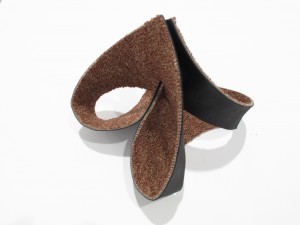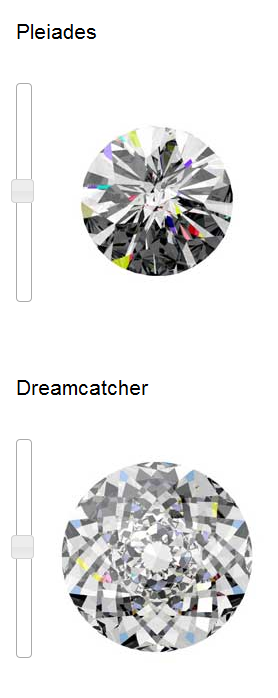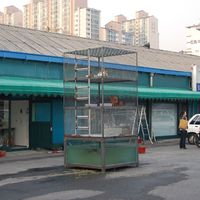Looking for lost diamonds in Antwerp | a residency project
 Artist collective Llobet & Pons talk about their latest project realised during a residency at Lokaal01, the Dutch-Flemish Space for Contemporary Art, in Antwerp, Belgium. The artist duo took a visual arts research perspective on the diamond industry in the Flemish capital, also known as the capital of the world diamond business.
Artist collective Llobet & Pons talk about their latest project realised during a residency at Lokaal01, the Dutch-Flemish Space for Contemporary Art, in Antwerp, Belgium. The artist duo took a visual arts research perspective on the diamond industry in the Flemish capital, also known as the capital of the world diamond business.If an unpolished diamond were lying on the ground, you wouldn’t even bother to pick it up. Hard to distinguish in the dirt, it has no particularly beautiful qualities of form or colour; in fact, it just looks like an ordinary stone. So what makes the difference to the value of a tiny stone, from worthless to a few hundreds, or even many thousands of Euros? For our project in Antwerp we developed an intense theoretical investigation into diamonds and created some new artworks as a result.
[caption id="attachment_27994" align="alignleft" width="300" caption="Llobet & Pons | H&A carpet | 2012"]
 [/caption]
[/caption]Our visual research developed through close observation of the very particular world of the diamond industry. For example, we noticed that many of the institutions we visited all had the same type of modular wall-to-wall carpet. This is because diamonds can easily fall out of your hands and once they hit the floor they jump about and can be difficult to find. This wouldn’t be a problem in most businesses but, in the diamond industry, it’s another matter. As someone told us, the level of employee control in this business is quite exhaustive with meticulous checks at entrance and exit to avoid any small stone being stolen. So carpets were very significant and we started working with those modules as a sculptural material, cutting, assembling them and searching for new forms.
During our stay in Antwerp we walked a lot, and also looked down on the ground, hoping to find some of those jumping diamonds. It’s not as unlikely as it sounds – eventually we did find a diamond … but it was a fake one.So we started a collection of the objects we found while we were looking for lost diamonds. We exhibited this at the end of the residency, together with the artworks, ideas and experiments we undertook. One of the objects exhibited was “Ex-spectacles”: for this, we contacted some polishing factories and asked if they could cut and polish unusual materials, such as spectacles lens glass, using diamond-cutting techniques. When we talked to the polisher, we found it wasn't possible with their machinery, so we made a ring out of the arm of a spectacles frame and for the stone we used a fake diamond, rather than a 'diamond' made of lens glass.
[caption id="attachment_27993" align="alignright" width="300" caption="Llobet & Pons | Ex-spectacles | ring, spectacles, fake diamond | 2012"]
 [/caption]
[/caption]Diamonds and Antwerp
Diamonds make up five percent of Belgium’s exports and 200 million Euros worth pass through Antwerp every day. A truly global product, diamonds arrive in the city in rough form and are sold to companies looking for the best prices. The cutting is usually done elsewhere, with the main centre in Mumbai and a lot also done in China. After that, the diamonds find their way back to Antwerp, this time as polished diamonds to be sold to dealers and jewellery stores.
For over five centuries Antwerp has been the centre of the international diamond trade. About 1,500 diamond firms, including rough diamond producers, raw stone dealers, manufacturers and polished diamond sellers, and the world’s two largest diamond banks are located there. These businesses are all are located in just two central streets, within walking distance of each other in the so-called diamond district of Antwerp.
It is not easy to visit the hermetic world of the diamond business and see what happens behind closed doors. The two streets are not particularly impressive or ostentatious, they seem like part of the normal urban landscape and, as with the rough diamond on the ground, you could pass by and ignore it. But behind those walls, diamonds are circulating and business being done like nowhere else.
Control and supervision
The import and export of diamonds is strictly controlled in Belgium by the government and the AWDC (Antwerp World Diamond Centre). All diamonds bought or sold in Belgium must pass through this institution to certify their origin and prevent trade in “conflict diamonds” (so-called “blood diamonds”). The Kimberley Process Certification Scheme was set up to ensure that diamond purchases were not financing violence by rebel movements and their allies seeking to undermine legitimate governments.
The film “Blood Diamond” (2006) drew attention to the smuggling and trade in diamonds undertaken by some countries to finance wars. These facts blur the brilliance of diamonds and, because of their high value, the dark side seems even harsher.
We had an interesting meeting at AWDC, where we were shown around and introduced to some institutions in the otherwise closed world of the diamond district: a grading laboratory, the Rough Diamond Bourse and a diamond polisher. We later visited the Diamond Pavilion and a diamond dealer and gained insights into this mysterious industry.
Prices and indexes
In contrast to precious metals such as gold, there are no international prices for diamonds. The value of a diamond depends on the quality of cut, colour, brilliance, etc. Most interestingly, some of these parameters are entirely subjective. The quality of a diamond cannot be scientifically proved and mostly depends on the viewer’s eye, along with their good will. The many variables and subjective aspects make it difficult to establish the price of a diamond – it has a lot to do with trusting the sources.
To certify the quality of a stone, institutions offer diamond-grading and verification services. However, few laboratories are internationally accepted and most of these are based in Antwerp. During our residency, we visited IGI, one of the top laboratories, and learned about their work. In room after room, we saw how the process of grading happens. In an atmosphere of quiet concentration, surrounded by the latest technology and security measures, all the properties of the stones are checked and verified. It was impressive to see how quickly diamonds were classified by colour, viewed under a microscope, or laser-engraved with their qualities and messages like “I love you, Rita” (a micro-inscription, invisible to the human eye, and also to our unskilled eyes looking through 10x magnification!).
There are also price indexes that help value diamonds depending on their certified quality. But, as we saw, quality assessment depends on subjective parameters and so these guides too cannot avoid subjectivity, and the prices vary from one guide to another. The index that is most accepted internationally is the weekly Rapaport Diamond Report.
[caption id="attachment_28048" align="alignright" width="222" caption="Pieter Bombeke | diamond cut designs"]
 [/caption]
[/caption]Diamond Bourses
In Antwerp, there are three diamond bourses for the polished diamond trade and the Antwerpsche Diamantkring, the only exchange in the world specialised in rough diamonds. We visited the bourse and met its director. Once these diamond trading bourses were a hive of frenetic activity; each member used to have their own chair engraved with their name, where they spent hours sitting and doing business, or just chatting or playing cards. This has changed over time. Now, business is done at the company offices and the bourses have taken on a more representative role.
Diamond Pavilion
To learn about the position of Antwerp as the world diamond centre, we went to the Diamond Pavilion at the recently opened MAS Museum, where a press officer gave us a lot of useful information on diamonds. It’s definitely worth a visit and the audio tour is excellent.
New forms of diamonds
And finally, we got a surprise when we visited Pieter Bombeke's studio and discovered that Pieter is a diamond-cutting innovator who invents his own diamond designs on computer and then cuts them for real. The diamond industry isn't normally creative – it’s a conservative world based on tradition where established forms are the ones that sell. Most polishers and cutters only make experimental works very rarely and to special order but for Pieter Bombeke, innovation is his duty.
Authors’ biography
Llobet & Pons are a visual artist collective based in Berlin and Barcelona. They have participated in international residency programmes in European and Asian countries, for example at Hangar in Barcelona, Akiyoshidai International Art Village (AIAV) in Japan; Seoul Art Space Geumcheon in South Korea and Platform Garanti in Istanbul. They have presented their artworks at international art spaces like Studio1 – Bethanien in Berlin and The Process Room at the Irish Museum of Modern Art in Dublin. Their forthcoming project for 2013 is the Setouchi Triennale in Japan.
Similar content
03 Dec 2010
10 Feb 2015 - 25 Mar 2015
13 Jun 2018 - 14 Jun 2018
01 Dec 2014 - 17 May 2015
posted on
27 May 2014



